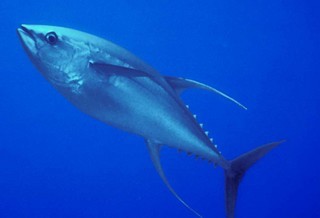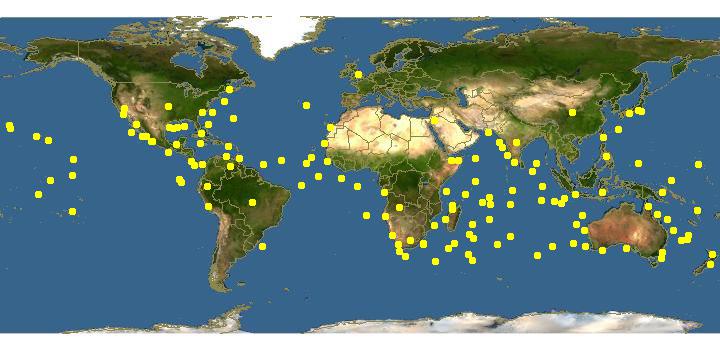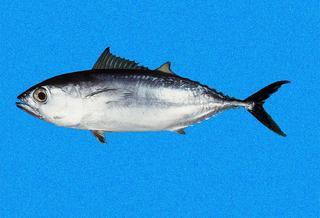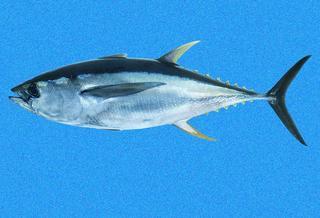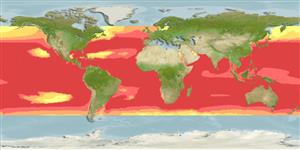|
| Links |
We parsed the following live from the Web into this page. Such content is managed by its original site and not cached on Discover Life. Please send feedback and corrections directly to the source. See original regarding copyrights and terms of use.
- Australian Faunal Directory
- FishBase
|
|
español |
|
|
Overview |
Main identification features
- dorsal fin and a: very long lobes
- pectoral: long (but not passing 2nd dorsal fin ), tip straight
- white bars - solid + spotted, on belly and rear body
Dorsal fins close together, the first with prolonged spines anteriorly, giving a strongly concave outline; first dorsal with XIII or XIV spines; second dorsal and anal fins becoming extremely tall in large specimens, well over 20 percent of fork length; 7-10 finlets behind second dorsal and anal fins; pectoral fins moderately long, in small fish tip is wide and rounded, in fish to 110cm fin does not reach past middle of D2 base; body with very small scales; anterior corselet of larger scales present, but not very distinct.
Back metallic dark blue, becoming yellow to silver on sides and belly; in fish up to 110cm belly and rear body with narrow vertical white bars, alternate bars are solid and spotted; dorsal and anal fins, including finlets, bright yellow, the finlets with a narrow black border.
Size: reaches 220 cm; all- tackle world record 176.4 Kg.
Habitat: oceanic pelagic.
Depth: 0-464 m.
Worldwide in tropical and subtropical seas; southern California to the SW and central eastern parts of the Gulf of California to Peru and the oceanic islands.
Attributes
Abundance: Common.
Cites: Not listed.
Climate Zone: North Temperate (Californian Province &/or Northern Gulf of California); Northern Subtropical (Cortez Province + Sinaloan Gap); Northern Tropical (Mexican Province to Nicaragua + Revillagigedos); Equatorial (Costa Rica to Ecuador + Galapagos, Clipperton, Cocos, Malpelo); South Temperate (Peruvian Province ).
Depth Range Max: 464 m.
Depth Range Min: 0 m.
Diet: Pelagic crustacea; octopus/squid/cuttlefish; bony fishes.
Eastern Pacific Range: Northern limit=33; Southern limit=-20; Western limit=-118; Eastern limit=-70; Latitudinal range=53; Longitudinal range=48.
Egg Type: Pelagic; Pelagic larva.
Feeding Group: Carnivore.
FishBase Habitat: Pelagic.
Global Endemism: Circumtropical ( Indian + Pacific + Atlantic Oceans); East Pacific + Atlantic (East +/or West); Transisthmian (East Pacific + Atlantic of Central America); East Pacific + all Atlantic (East+West); All Pacific (West + Central + East); TEP non-endemic; "Transpacific" (East + Central &/or West Pacific); All species.
Habitat: Flotsam; Water column.
Inshore Offshore: Offshore; Offshore Only.
IUCN Red List: Not evaluated / Listed.
Length Max: 220 cm.
Regional Endemism: Island (s); Continent; Continent + Island (s); Tropical Eastern Pacific (TEP) non-endemic; Eastern Pacific non-endemic; All species.
Residency: Resident.
Salinity: Marine; Marine Only.
Water Column Position: Mid Water; Near Surface; Surface; Water column only;
|
|
|
Names | |
|
|
|
Links to other sites | |
|
|
|
References |
- Acero, A. and Franke, R., 2001., Peces del parque nacional natural Gorgona. En: Barrios, L. M. y M. Lopéz-Victoria (Eds.). Gorgona marina: Contribución al conocimiento de una isla única., INVEMAR, Serie Publicaciones Especiales No. 7:123-131.
- Allen , G.R. and Robertson, D.R., 1997., An Annotated Checklist of the fishes of Clipperton Atoll, Tropical Eastern Pacific., Revista de Biologia Tropical, 45:813-843.
- Bonnaterre, J. P., 1788., Tableau encyclopédique et méthodique des trois règnes de la nature... Ichthyologie. Paris., Tabl. Encyclop. Méthod. Ichthyol., :1-215.
- Béarez, P., 1996., Lista de los Peces Marinos del Ecuador Continental., Revista de Biologia Tropical, 44:731-741.
- Castro-Aguirre, J.L. and Balart, E.F., 2002., La ictiofauna de las islas Revillagigedos y sus relaciones zoogeograficas, con comentarios acerca de su origen y evolucion. En: Lozano-Vilano, M. L. (Ed.). Libro Jubilar en Honor al Dr. Salvador Contreras Balderas., Universidad Autonoma de Nuevo León:153-170.
- Collette , B. B. and Nauen, C. E., 1983., Scombrids of the world. An annotated and illustrated catalogue of tunas, mackerels, bonitos and related species known to date. FAO species catalogue Vol. 2., FAO Fish. Synop. No 125, 125.
- Collette, B.B., 1999., Mackerels, molecular, and morphology. In Proc. 5th Indo-Pac. Fish. Conf. Nouméa, 1977. Séret B. & J. Sire. Eds., Soc. Fr. Ichtyol.:149-164.
- Collette, B.B., Reeb, C. and Block, B.A., 2001., Systematics of the tunas and mackerels (Scombridae)., Fish Physiology, 19:1-33.
- Eschmeyer , W. N. , Herald , E. S. and Hamman, H., 1983., A field guide to Pacific coast fishes of North America from the Gulf of Alaska to Baja California. Peterson Field Guide Ser. 28., Houghton Mifflin:336pp.
- Findley, L.T., Hendrickx, M.E., Brusca, R.C., van der Heiden, A.M., Hastings, P.A., Torre, J., 2003., Diversidad de la Macrofauna Marina del Golfo de California, Mexico., CD-ROM versión 1.0. Projecto de la Macrofauna del Golfo . Derechos reservados de los autores y Conservación Internacional.
- Fischer , W. , Krup , F. , Schneider , W. , Sommer , C. , Carpenter , K. E. and Niem, V. H., 1995., Guia FAO para la Identificacion de Especies de para los fines de la Pesca. Pacifico Centro-Oriental. Volumen III. Vertebrados - Parte 2., FAO3:1201-1813.
- Fowler, H.W., 1944., Results of the Fifth George Vanderbilt Expedition (1941) (Bahamas, Caribbean sea, Panama, Galapagos Archipelago and Mexican Pacific Islands). The Fishes., Acad. Nat. Sci. Philadel., Monographs, 6:57-529.
- Franke , R. and Acero P., A., 1992., Peces óseos comerciales del Parque Gorgona, Pacífico Colombiano (Osteichthyes: Elopidae, Chanidae, Exocoetidae, Belonidae y Scombridae)., Revista de Biologia Tropical, 40:117-124.
- Galván-Magaña, F., Abitia-Cárdenas, L.A., Rodríguez-Romero, J., Pérez-España, H., Chávez-Ramos, H., 1996., Systematics list of the fishes from Cerralvo island, Baja California Sur, Mexico., Ciencias Marinas, 22:295-311.
- Galván-Magaña, F., Gutiérrez-Sánchez, F., Abitia-Cárdenas, L.A., Rodríguez-Romero, J., 2000., The distribution and affinities of the shore fishes of the Baja California Sur lagoons. In Aquatic Ecosystems of Mexico: Status and Scope. Eds. M. Manuwar, S.G. Lawrence, I.F. Manuwar & D.F. Malley. Ecovision World Monograph Series., Backhuys Publishers:383-398.
- Gotshall, D.W., 1996., Fishes of Rocas Alijos. In Rocas Alijos. Ed. R. W. Schmieder. Cornell Expeditions., Kluwer Academic Publishers: 347-354.
- Grove , J.S. and Lavenberg, R. J., 1997., The fishes of the Galápagos islands., Stanford University Press:863 pp.
- Hildebrand, S.F., 1946., A descriptive catalog of the shore fishes of Peru., Bull. U.S. Nat. Mus., 189:1-530.
- Humann, P., 1993., Reef Fish Identification: Galapagos., New World Publishing:192pp.
- Hunter, J. R. and Mitchell, C. T., 1966., Association of fishes with flotsam in the offshore waters of Central America., Fishery Bulletin, 66:13-29.
- Jimenez-Prado, P., Béarez, P., 2004., Peces marinos del Ecuador continental / Marine fishes of continental Ecuador., SIMBIOE/NAZCA/IFEA tomo 1 y 2.
- Joseph , J. , Klawe , W. and Murphy, P., 1988., Tuna and Billfish - fish without a country., Inter-American Tropical Tuna Commission:69.
- Lopez , M. I. and Bussing, W. A., 1982., Lista provisional de los peces marinos de la Costa Rica., Revista de Biologia Tropical, 30(1):5-26.
- Love, M.S., Mecklenburg, C.W., Mecklenburg, T.A., Thorsteinson, L.K., 2005., es of the West Coast and Alaska: a checklist of North Pacific and Artic Ocena species from Baja California to the Alaska-Yukon border., U.S. Department of the Interior, U.S. Geological Survey, Biological Resources Division, 288pp.
- Molina, L., Danulat, E., Oviedo, M., González, J.A., 2004., Guía de especies de interés pesquero en la Reserva Marina de Galápagos., Fundación Charles Darwin / Agencia Espeñola de Cooperación Internacional / Dirección Parque Nacional Galápagos, 115pp.
- Ramírez Rodríguez, M., 1997., Producción pesquera en la Bahía de La Paz, B.C.S.. En Urbán Ramírez, J. y M. Ramírez Rodríguez (Eds.). La Bahía de La Paz investigación y conservación., Universidad Autónoma de Baja California Sur:273-282.
- Ricker, K.E., 1959., Fishes collected from the Revillagigedo Islands during the 1954-1958 cruises of the "Marijean."., Univ. Brit. Columbia Inst. Fish., Mus. Contrib., 4:10pp.
- Robertson , D.R. and Allen, G.A., 1996., Zoogeography of the shorefish fauna of Clipperton Atoll., Coral Reefs, 15:121-131.
- Rubio, E.A., 1986., Notas sobre la ictiofauna de la Isla de Gorgona, Colombia., Boletin Ecotropica. Univ. Bog. Jorge Tadeo Lozano, 13:86-112.
- Schaefer, K. M., 1999., Comparative study of some morphological features of yellowfin (Thunnus albacares) and bigeye (Thunnus obesus) tunas., Inter-American Tropical Tuna Commission, 21(7):491-516.
- Schaefer, K. M., 2001., Reproductive biology of tunas., Fish Physiology, 19:225-270.
- Sánchez Ortíz , C. , Arreola Robles , J. L. , Aburto Oropeza , O. and Cortés Hernández, M., 1997., Peces de arrecife en la región de La Paz, B.C.S.. En Urbán Ramírez, J. y M. Ramírez Rodríguez (Eds.). La Bahía de La Paz investigación y conservación., Universidad Autónoma de Baja California Sur:189-200.
- Van der Heiden , A. M. and Findley, L. T., 1988., Lista de los peces marinos del sur de Sinaloa, México., Anales del Centro de Ciencias del Mar y Limnologia de la Universidad Autonoma Nacional de Mexico, 15:209-224.
- Villareal-Cavazos, A., Reyes-Bonilla, H., Bermúdez-Almada, B. and Arizpe-Covarrubias, O., 2000., Los peces del arrecife de Cabo Pulmo, Golfo de California, México: Lista sistemática y aspectos de abundancia y biogeografía., Rev. Biol. Trop., 48:413-424.
|
|
|
Acknowledgements | |
I thank Ashley MacDonald and John Pickering, University of Georgia, for technical support in building this page.
|
|
| Supported by | |
|
Following modified from Australian Faunal Directory
|
Top | See original
| &pull 20q v5.145 20180528: Error 301 Moved Permanently http://biodiversity.org.au/afd/taxa/66b058dc-6951-47db-82c4-c45a1aae5b58 |
|
Following modified from FishBase
|
Top | See original
http://www.fishbase.org/Summary/speciesSummary.php?genusname=Thunnus&speciesname=albacares ---> http://52.67.158.155/Summary/speciesSummary.php?genusname=Thunnus&speciesname=albacares
http://52.67.158.155/Summary/speciesSummary.php?genusname=Thunnus&speciesname=albacares ---> https://fishbase.net.br/Summary/speciesSummary.php?genusname=Thunnus&speciesname=albacares
https://fishbase.net.br/Summary/speciesSummary.php?genusname=Thunnus&speciesname=albacares ---> https://fishbase.net.br/summary/Thunnus-albacares.html
Thunnus albacares, Yellowfin tuna : fisheries, aquaculture, gamefish

You can
sponsor
this page
Common name (e.g. trout)
Genus + Species (e.g. Gadus morhua)
-

-
About this page
-
Languages
-
User feedbacks
-
Citation
-
Uploads
-
Related species
-


 Yellowfin tuna
Add your observation in
Fish Watcher
Upload your
photos
and
videos
Yellowfin tuna
Add your observation in
Fish Watcher
Upload your
photos
and
videos
Pictures
|
Videos |
Stamps, Coins Misc.
|
Google image
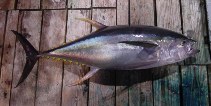 Thunnus albacares
Thunnus albacares
Picture by
Archambault, C.
Teleostei (teleosts) >
Scombriformes
(Mackerels) >
Scombridae
(Mackerels, tunas, bonitos) > Scombrinae
Etymology:
Thunnus:
Greek, thynnos = tunna (Ref.
45335
)
.
More on author:
Bonnaterre
.
Environment: milieu / climate zone / depth range / distribution range
Ecology
Marine; brackish; pelagic-oceanic; oceanodromous (Ref.
51243
); depth range 1 - 1602 m, usually 1 - 250 m (Ref.
6390
). Tropical; 15°C - 31°C (Ref.
168
); 50°N - 50°S, 180°W - 180°E
Worldwide in tropical and subtropical seas, but absent from the Mediterranean Sea. Highly migratory species.
Length at first maturity / Size / Weight / Age
Maturity: L
m
103.3
, range 78 - 158 cm
Max length : 239 cm FL male/unsexed; (Ref.
40637
); common length : 150 cm FL male/unsexed; (Ref.
168
); max. published weight: 200.0 kg (Ref.
26550
); max. reported age: 9 years (Ref.
72462
)
Dorsal
spines
(total): 11 - 14;
Dorsal
soft rays
(total): 12-16;
Anal
spines
: 0;
Anal
soft rays
: 11 - 16;
Vertebrae
: 39. This large species is distinguished by the following characters: elongate, fusiform body, slightly compressed laterally; total gill rakers on first gill arch 26-34; dorsal fins 2 and separated only by a narrow interspace, the second followed by 8-10 finlets; anal fin followed by 7 to 10 finlets; large specimens may have very long second dorsal and anal fins, becoming well over 20% of fork length; pectoral fins moderately long, usually reaching beyond second dorsal-fin origin but not beyond end of its base, usually 22-31% of FL; 2 flaps (interpelvic process) between pelvic fins; body with very small scales; corselet of larger scales developed but not very distinct; caudal peduncle very slender, bearing on each side a strong lateral keel between 2 smaller keels; no striations on ventral surface of liver; swimbladder present. Colour of back metallic dark blue changing through yellow to silver on belly; belly frequently crossed by about 20 broken, nearly vertical lines; dorsal and anal fins, and dorsal and anal finlets bright yellow, the finlets with a narrow black border (Ref.
9684
).
An oceanic species occurring above and below the thermoclines. Pelagic in open water , but rarely seen near reefs (Ref.
48637
). They school primarily by size, either in monospecific or multi-species groups. Larger fish frequently school with porpoises, also associated with floating debris and other objects. Feed on fishes, crustaceans and squids. It is sensitive to low concentrations of oxygen and therefore is not usually caught below 250 m in the tropics (Ref.
28952
,
30329
). Peak spawning occurs during the summer, in batches (Ref.
9684
,
51846
). Eggs and larvae are pelagic (Ref.
6769
). Encircling nets are employed to catch schools near the surface (Ref.
9340
). Caught mainly with longlines and purse seines. Marketed mainly fresh, frozen, canned (Ref.
9684
), but also smoked (Ref.
9987
). Highly valued for sashimi (Ref.
26938
).
Spawn throughout the tropical and equatorial waters of the major oceans (Ref.
6390
). At higher latitudes, spawning is seasonal, with peaks in summer; may continue throughout the year at lower latitudes (Ref.
6390
). Yellowfin tuna are multiple spawners, ie they spawn every few days over the spawning period (Ref.
6390
). Eggs and sperm are released into the water for fertilisation (Ref.
6390
).
Collette, B.B. and C.E. Nauen
, 1983. FAO Species Catalogue. Vol. 2. Scombrids of the world. An annotated and illustrated catalogue of tunas, mackerels, bonitos and related species known to date. Rome: FAO. FAO Fish. Synop. 125(2):137 p. (Ref.
168
)
IUCN Red List Status (Ref.
130435
)
Least Concern (LC)
; Date assessed:
15 January 2021
CITES
Not Evaluated
Not Evaluated
Threat to humans
Harmless
Human uses
Fisheries: highly commercial; aquaculture: experimental; gamefish: yes
FAO - Aquaculture:
production
; Fisheries:
landings
,
species profile
; Publication:
search
| FIRMS -
Stock assessments
|
FishSource
|
Sea Around Us
More information
Countries
FAO areas
Ecosystems
Occurrences
Introductions
Stocks
Ecology
Diet
Food items
Food consumption
Ration
Common names
Synonyms
Metabolism
Predators
Ecotoxicology
Reproduction
Maturity
Spawning
Spawning aggregation
Fecundity
Eggs
Egg development
Age/Size
Growth
Length-weight
Length-length
Length-frequencies
Morphometrics
Morphology
Larvae
Larval dynamics
Recruitment
Abundance
BRUVS
References
Aquaculture
Aquaculture profile
Strains
Genetics
Electrophoreses
Heritability
Diseases
Processing
Nutrients
Mass conversion
Collaborators
Pictures
Stamps, Coins Misc.
Sounds
Ciguatera
Speed
Swim. type
Gill area
Otoliths
Brains
Vision
Tools
E-book
|
Field guide
|
Identification keys
|
Length-frequency wizard
|
Life-history tool
|
Point map
|
Classification Tree
|
Catch-MSY
|
Special reports
Check for Aquarium maintenance
|
Check for Species Fact Sheets
|
Check for Aquaculture Fact Sheets
Download XML
Summary page
|
Point data
|
Common names
|
Photos
Internet sources
AFORO (otoliths)
|
Aquatic Commons
|
BHL
|
Cloffa
|
BOLDSystems
|
Websites from users
|
Check FishWatcher
|
CISTI
|
Catalog of Fishes
:
genus
,
species
|
DiscoverLife
|
ECOTOX
| FAO - Aquaculture:
production
; Fisheries:
landings
,
species profile
; Publication:
search
|
Faunafri
|
Fishipedia
|
Fishtrace
| GenBank:
genome
,
nucleotide
|
GloBI
|
GoMexSI
(interaction data)
|
Google Books
|
Google Scholar
|
Google
|
IGFA World Record
|
MitoFish
|
National databases
| OsteoBase:
skull
,
spine
|
Otolith Atlas of Taiwan Fishes
|
Public aquariums
|
PubMed
| Reef Life Survey |
RFE Identification
|
Socotra Atlas
|
Tree of Life
| Wikipedia:
Go
,
Search
| World Records Freshwater Fishing |
Zoological Record
Estimates based on models
Preferred temperature (Ref.
123201
): 16.5 - 28.9, mean 26.7 °C (based on 6382 cells).
Phylogenetic diversity index (Ref.
82804
): PD
50
= 0.5039 [Uniqueness, from 0.5 = low to 2.0 = high].
Bayesian length-weight: a=0.01479 (0.01210 - 0.01808), b=3.03 (2.99 - 3.07), in cm total length, based on LWR estimates for this species (Ref.
93245
).
Trophic level (Ref.
69278
): 4.4 ±0.4 se; based on diet studies.
Generation time: 2.8 (2.3 - 3.5) years. Estimated as median ln(3)/K based on 46
growth studies.
Resilience (Ref.
120179
): Medium, minimum population doubling time 1.4 - 4.4 years (K=0.13-0.42; tm=2-5; tmax=8; Fec=200,000).
Prior r = 0.57, 95% CL = 0.37 - 0.85, Based on 5 stock assessments.
Fishing Vulnerability (Ref.
59153
): Moderate to high vulnerability (46 of 100).
Climate Vulnerability (Ref.
125649
): Moderate vulnerability (42 of 100).
Price category (Ref.
80766
):
High
.
Nutrients (Ref.
124155
): Calcium = 41 [22, 86] mg/100g; Iron = 2.84 [1.17, 6.68] mg/100g; Protein = 23.7 [22.2, 25.1] %; Omega3 = 0.274 [0.166, 0.457] g/100g; Selenium = 82.4 [21.0, 256.4] μg/100g; VitaminA = 29.6 [3.7, 227.6] μg/100g; Zinc = 0.524 [0.292, 0.972] mg/100g (wet weight); based on
nutrient studies.
Back to Search
Random Species
Back to Top
Accessed through:
Not available
FishBase mirror site :
Laguna, Philippines
Page last modified by :
mrius-barile
|
Updated: 2024-04-26 14:05:54 gmt
|
